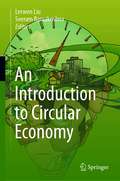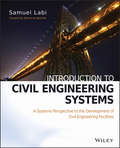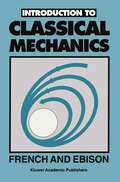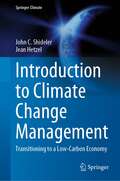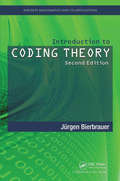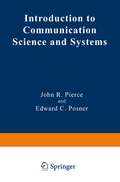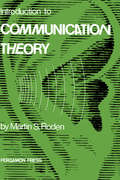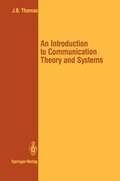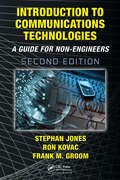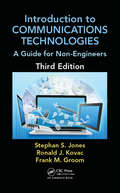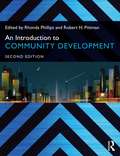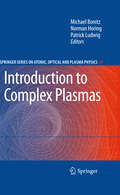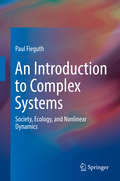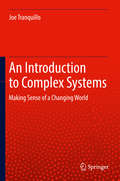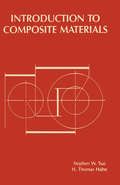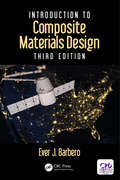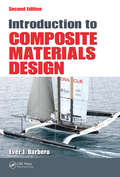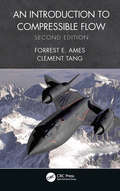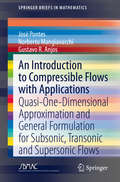- Table View
- List View
An Introduction to Circular Economy
by Seeram Ramakrishna Lerwen LiuThis book is purposefully styled as an introductory textbook on circular economy (CE) for the benefit of educators and students of universities. It provides comprehensive knowledge exemplified by practices from policy, education, R&D, innovation, design, production, waste management, business and financing around the world. The book covers sectors such as agriculture/food, packaging materials, build environment, textile, energy, and mobility to inspire the growth of circular business transformation. It aims to stimulate action among different stakeholders to drive CE transformation. It elaborates critical driving forces of CE including digital technologies; restorative innovations; business opportunities & sustainable business model; financing instruments, regulation & assessment and experiential education programs. It connects a CE transformation for reaching the SDGs2030 and highlights youth leadership and entrepreneurship at all levels in driving the sustainability transformation.
Introduction to Civil Engineering Systems: A Systems Perspective to the Development of Civil Engineering Facilities
by Samuel LabiThis book presents an integrated systems approach to the evaluation, analysis, design, and maintenance of civil engineering systems. Addressing recent concerns about the world's aging civil infrastructure and its environmental impact, the author makes the case for why any civil infrastructure should be seen as part of a larger whole. He walks readers through all phases of a civil project, from feasibility assessment to construction to operations, explaining how to evaluate tasks and challenges at each phase using a holistic approach. Unique coverage of ethics, legal issues, and management is also included.
Introduction to Civil Engineering Systems: A Systems Perspective to the Development of Civil Engineering Facilities
by Samuel LabiThis book presents an integrated systems approach to the evaluation, analysis, design, and maintenance of civil engineering systems. Addressing recent concerns about the world's aging civil infrastructure and its environmental impact, the author makes the case for why any civil infrastructure should be seen as part of a larger whole. He walks readers through all phases of a civil project, from feasibility assessment to construction to operations, explaining how to evaluate tasks and challenges at each phase using a holistic approach. Unique coverage of ethics, legal issues, and management is also included.
Introduction to CLASSICAL MECHANICS
by A.J. French M.G. EbisonThis book is, in essence, an updated and revised version of an earlier textbook, Newtonian Mechanics, written about fifteen years ago by one of us (APF) and published in 1971. The book has been significantly changed in emphasis as well as length. Our aim has been to produce a mechanics text, suitable for use at beginning university level, for students who have a background typified by the British sixth-form level in physics and mathematics. We hope, however, that the book will also be found useful in the teaching of mechanics at the upper levels of the secondary schools themselves. Calculus is freely used from the outset. In making the present revision we have drastically cut down on the amount of historical and more discursive material. Nevertheless, our goal has been to present classical mechanics as physics, not as applied mathematics. Although we begin at the beginning, we have aimed at developing the basic principles and their applications as rapidly as seemed reasonable, so that by the end of the book students will be able to feel that they have achieved a good working knowledge of the subject and can tackle fairly sophisticated problems. To help with this process, each chapter is followed by a good number of exercises, some of them fairly challenging. We shall be very grateful to receive comments and corrections from those who use this book.
Introduction to Climate Change Management: Transitioning to a Low-Carbon Economy (Springer Climate)
by John C. Shideler Jean HetzelThis book provides climate students with the basic scientific background to climate change management. Students will learn about international and national approaches to climate change management defined in voluntary initiatives as well as in national law and international agreements. The book describes mitigation and adaptation measures, monitoring and reporting of greenhouse gas emissions, and strategies for achieving a low-carbon economy, including green finance.This book combines theory and practice, introducing students to the conceptual background but also taking a professional and technical approach with case studies and low carbon toolkits. Filled with didactic elements such as concept schemes, tables, charts, figures, examples, as well as questions and answers at the end of the chapters, this book aims to engage critical thinking and the discussion of important topics of our days.The low-carbon strategy is one of the answers to limiting the greenhouse effect on our planet. This strategy is to minimize the overall carbon consumption in the life cycle of the products we consume, from the extraction of raw materials to the end of their life. The future is being built today. This book will guide its readers along the path of imagining and realizing a low-carbon economy.”
Introduction to Coding Theory (Discrete Mathematics and Its Applications)
by Jurgen BierbrauerThis book is designed to be usable as a textbook for an undergraduate course or for an advanced graduate course in coding theory as well as a reference for researchers in discrete mathematics, engineering and theoretical computer science. This second edition has three parts: an elementary introduction to coding, theory and applications of codes, and algebraic curves. The latter part presents a brief introduction to the theory of algebraic curves and its most important applications to coding theory.
Introduction to Communication Science and Systems (Applications of Communications Theory)
by John R. Pierce Edward C. PosnerThere are many valuable and useful books on electrical communication (References 1-5 are some examples), but they have certain disadvantages for the beginner. The more advanced books present some things in a basic way, but they are very narrow for an introduction to communica tion. The introductory books are broader but still narrow by our stan dards. Further, they often pick things out of thin air rather than derive them. This book is aimed at giving the beginner a basic understanding of a wide range of topics which are essential in communication systems. These include antennas and transmission, thermal noise and its consequences, Fourier transforms, modulation and noise, sampling and pulse code modulation, autocorrelation and power spectrum, optimum filtering, gauss ian noise and errors in digital transmission, data transmission, limits on data rate including information theory and quantum limits, and source encoding. We have not included communications traffic, switching, and multiplexing, nor protocols for digital and computer communications. For these, Reference 6 is excellent. In general, our book does not discuss the circuits used for communication or the physics of radio propagation. We assume that these will be taught in specialized courses, but such courses are not prerequisites for this one. Chapter 1 introduces the transmission formula or antenna equation and antenna directivity. Only a very basic sophomore physics knowledge of electromagnetic theory is assumed. The radar equation is also treated.
Introduction to Communication Theory
by Martin S. RodenIntroduction to Communication Theory encompasses the body of knowledge contained in a quarter course in Communication Theory taught at the California State College, L.A. Organized into six chapters, this book first addresses the mathematical groundwork of signal analysis. Chapter 2 then applies this to the study of linear systems with emphasis upon filter theory. Subsequent chapters apply the developed theory to various communication systems, particularly in the study of amplitude, frequency, and pulse modulation. The last chapter describes the techniques of noise analysis. This text will be very useful to students in the field of communications.
An Introduction to Communication Theory and Systems (Springer Texts in Electrical Engineering)
by John B. ThomasThis book was written as a first treatment of statistical com munication theory and communication systems at a senior graduate level. The only formal prerequisite is a knowledge of ele mentary calculus; however, some familiarity with linear systems and transform theory will be helpful. Chapter 1 is introductory and contains no substantial techni cal material. Chapter 2 is an elementary introduction to probability theory at a nonrigorous and non abstract level. It is essential to the remainder of the book but may be skipped (or reviewed has tily) by any student who has taken a one-semester undergraduate course in probability. Chapter 3 is a brief treatment of random processes and spec tral analysis. It includes an introduction to shot noise (Sections 3.14-3.17) which is not subsequently used explicitly. Chapter 4 considers linear systems with random inputs. It includes a considerable amount of material on narrow-band sys tems and on the representation of random processes. Chapter 5 treats the matched filter and the linear least mean-squared-error filter at an elementary level but in some detail. Numerous examples are provided throughout the book. Many of these are of an elementary nature and are intended merely to illustrate textual material. A reasonable number of problems of varying difficulty are provided. Instructors who adopt the text for classroom use may obtain a Solutions Manual for most of the problems by writing to the author.
Introduction to Communications Technologies: A Guide for Non-Engineers, (2nd Edition) (PDF)
by Stephan JonesThanks to the advancement of faster processors within communication devices, there has been a rapid change in how information is modulated, multiplexed, managed, and moved. While formulas and functions are critical in creating the granular components and operations of individual technologies, understanding the applications and their purposes in the
Introduction to Communications Technologies: A Guide for Non-Engineers, Third Edition (Technology For Non-engineers Ser.)
by Stephan Jones Ronald J. Kovac Frank M. GroomThanks to the advancement of faster processors within communication devices, there has been a rapid change in how information is modulated, multiplexed, managed, and moved. While formulas and functions are critical in creating the granular components and operations of individual technologies, understanding the applications and their purposes in the
Introduction to Communications Technologies: A Guide for Non-Engineers, Third Edition
by Stephan Jones Ronald J. Kovac Frank M. GroomThanks to the advancement of faster processors within communication devices, there has been a rapid change in how information is modulated, multiplexed, managed, and moved. While formulas and functions are critical in creating the granular components and operations of individual technologies, understanding the applications and their purposes in the
An Introduction to Community Development
by Rhonda Phillips Robert PittmanBeginning with the foundations of community development, An Introduction to Community Development offers a comprehensive and practical approach to planning for communities. Road-tested in the authors’ own teaching, and through the training they provide for practicing planners, it enables students to begin making connections between academic study and practical know-how from both private and public sector contexts. An Introduction to Community Development shows how planners can utilize local economic interests and integrate finance and marketing considerations into their strategy. Most importantly, the book is strongly focused on outcomes, encouraging students to ask: what is best practice when it comes to planning for communities, and how do we accurately measure the results of planning practice? This newly revised and updated edition includes: increased coverage of sustainability issues, discussion of localism and its relation to community development, quality of life, community well-being and public health considerations, and content on local food systems. Each chapter provides a range of reading materials for the student, supplemented with text boxes, a chapter outline, keywords, and reference lists, and new skills based exercises at the end of each chapter to help students turn their learning into action, making this the most user-friendly text for community development now available.
An Introduction to Community Development
by Rhonda Phillips Robert PittmanBeginning with the foundations of community development, An Introduction to Community Development offers a comprehensive and practical approach to planning for communities. Road-tested in the authors’ own teaching, and through the training they provide for practicing planners, it enables students to begin making connections between academic study and practical know-how from both private and public sector contexts. An Introduction to Community Development shows how planners can utilize local economic interests and integrate finance and marketing considerations into their strategy. Most importantly, the book is strongly focused on outcomes, encouraging students to ask: what is best practice when it comes to planning for communities, and how do we accurately measure the results of planning practice? This newly revised and updated edition includes: increased coverage of sustainability issues, discussion of localism and its relation to community development, quality of life, community well-being and public health considerations, and content on local food systems. Each chapter provides a range of reading materials for the student, supplemented with text boxes, a chapter outline, keywords, and reference lists, and new skills based exercises at the end of each chapter to help students turn their learning into action, making this the most user-friendly text for community development now available.
Introduction to Complex Plasmas (Springer Series on Atomic, Optical, and Plasma Physics #59)
by Michael Bonitz Norman Horing Patrick LudwigComplex plasmas differ from traditional plasmas in many ways: these are low-temperature high pressure systems containing nanometer to micrometer size particles which may be highly charged and strongly interacting. The particles may be chemically reacting or be in contact with solid surfaces, and the electrons may show quantum behaviour. These interesting properties have led to many applications of complex plasmas in technology, medicine and science. Yet complex plasmas are extremely complicated, both experimentally and theoretically, and require a variety of new approaches which go beyond standard plasma physics courses. This book fills this gap presenting an introduction to theory, experiment and computer simulation in this field. Based on tutorial lectures at a very successful recent Summer Institute, the presentation is ideally suited for graduate students, plasma physicists and experienced undergraduates.
An Introduction to Complex Systems: Society, Ecology, and Nonlinear Dynamics
by Paul FieguthThis undergraduate text explores a variety of large-scale phenomena - global warming, ice ages, water, poverty - and uses these case studies as a motivation to explore nonlinear dynamics, power-law statistics, and complex systems. Although the detailed mathematical descriptions of these topics can be challenging, the consequences of a system being nonlinear, power-law, or complex are in fact quite accessible. This book blends a tutorial approach to the mathematical aspects of complex systems together with a complementary narrative on the global/ecological/societal implications of such systems.Nearly all engineering undergraduate courses focus on mathematics and systems which are small scale, linear, and Gaussian. Unfortunately there is not a single large-scale ecological or social phenomenon that is scalar, linear, and Gaussian. This book offers students insights to better understand the large-scale problems facing the world and to realize that these cannot be solved by a single, narrow academic field or perspective. Instead, the book seeks to emphasize understanding, concepts, and ideas, in a way that is mathematically rigorous, so that the concepts do not feel vague, but not so technical that the mathematics get in the way. The book is intended for undergraduate students in a technical domain such as engineering, computer science, physics, mathematics, and environmental studies.
An Introduction to Complex Systems: Making Sense of a Changing World
by Joe TranquilloThis book explores the interdisciplinary field of complex systems theory. By the end of the book, readers will be able to understand terminology that is used in complex systems and how they are related to one another; see the patterns of complex systems in practical examples; map current topics, in a variety of fields, to complexity theory; and be able to read more advanced literature in the field. The book begins with basic systems concepts and moves on to how these simple rules can lead to complex behavior. The author then introduces non-linear systems, followed by pattern formation, and networks and information flow in systems. Later chapters cover the thermodynamics of complex systems, dynamical patterns that arise in networks, and how game theory can serve as a framework for decision making. The text is interspersed with both philosophical and quantitative arguments, and each chapter ends with questions and prompts that help readers make more connections.
Introduction to Composite Materials
by StephenW. TsaiA widely used basic text by two recognized authorities. A unified and disciplined approach; advanced concepts reduced to easy-to-use charts, formulas and numerical examples.
Introduction to Composite Materials
by StephenW. TsaiA widely used basic text by two recognized authorities. A unified and disciplined approach; advanced concepts reduced to easy-to-use charts, formulas and numerical examples.
Introduction to Composite Materials Design (Composite Materials)
by Ever J. BarberoThe Third Edition of Introduction to Composite Materials Design is a practical, design-oriented textbook aimed at students and practicing engineers learning analysis and design of composite materials and structures. Readers will find the Third Edition to be both highly streamlined for teaching, with new comprehensive examples and exercises emphasizing design, as well as complete with practical content relevant to current industry needs. Furthermore, the Third Edition is updated with the latest analysis techniques for the preliminary design of composite materials, including universal carpet plots, temperature dependent properties, and more. Significant additions provide the essential tools for mastering Design for Reliability as well as an expanded material property database.
Introduction to Composite Materials Design (Composite Materials Ser.)
by Ever J. BarberoPresenting a wealth of completely revised examples and new information, Introduction to Composite Materials Design, Second Edition greatly improves on the bestselling first edition. It incorporates state-of-the-art advances in knowledge and design methods that have taken place over the last 10 years, yet maintains the distinguishing features and vi
Introduction to Composite Materials Design (Composite Materials)
by Ever J. BarberoThe third edition of Introduction to Composite Materials Design is a practical, design-oriented textbook aimed at students and practicing engineers learning analysis and design of composite materials and structures. Readers will find the third edition to be both highly streamlined for teaching, with new comprehensive examples and exercises emphasizing design, as well as complete with practical content relevant to current industry needs. Furthermore, the third edition is updated with the latest analysis techniques for the preliminary design of composite materials, including universal carpet plots, temperature dependent properties, and more. Significant additions provide the essential tools for mastering Design for Reliability as well as an expanded material property database.
An Introduction to Compressible Flow
by Forrest E. Ames Clement C. TangAn Introduction to Compressible Flow, Second Edition covers the material typical of a single-semester course in compressible flow. The book begins with a brief review of thermodynamics and control volume fluid dynamics, then proceeds to cover isentropic flow, normal shock waves, shock tubes, oblique shock waves, Prandtl-Meyer expansion fans, Fanno-line flow, Rayleigh-line flow, and conical shock waves. The book includes a chapter on linearized flow following chapters on oblique shocks and Prandtl-Meyer flows to appropriately ground students in this approximate method. It includes detailed appendices to support problem solutions and covers new oblique shock tables, which allow for quick and accurate solutions of flows with concave corners. The book is intended for senior undergraduate engineering students studying thermal-fluids and practicing engineers in the areas of aerospace or energy conversion. This book is also useful in providing supplemental coverage of compressible flow material in gas turbine and aerodynamics courses.
An Introduction to Compressible Flow
by Forrest E. Ames Clement C. TangAn Introduction to Compressible Flow, Second Edition covers the material typical of a single-semester course in compressible flow. The book begins with a brief review of thermodynamics and control volume fluid dynamics, then proceeds to cover isentropic flow, normal shock waves, shock tubes, oblique shock waves, Prandtl-Meyer expansion fans, Fanno-line flow, Rayleigh-line flow, and conical shock waves. The book includes a chapter on linearized flow following chapters on oblique shocks and Prandtl-Meyer flows to appropriately ground students in this approximate method. It includes detailed appendices to support problem solutions and covers new oblique shock tables, which allow for quick and accurate solutions of flows with concave corners. The book is intended for senior undergraduate engineering students studying thermal-fluids and practicing engineers in the areas of aerospace or energy conversion. This book is also useful in providing supplemental coverage of compressible flow material in gas turbine and aerodynamics courses.
An Introduction to Compressible Flows with Applications: Quasi-One-Dimensional Approximation and General Formulation for Subsonic, Transonic and Supersonic Flows (SpringerBriefs in Mathematics)
by José Pontes Norberto Mangiavacchi Gustavo R. AnjosThis book offers a concise and practical survey of the principles governing compressible flows, along with selected applications.It starts with derivation of the time-dependent, three-dimensional equation of compressible potential flows, and a study of weak waves, including evaluation of the sound speed in gases. The following chapter addresses quasi-one-dimensional flows, the study of normal shock waves, and flow in ducts with constant cross section subjected to friction and/or heat transfer. It also investigates the effects of friction and heat transfer in ducts with variable cross section. The chapter ends by pointing to the analogy between one-dimensional compressible flows and open channel hydraulics.Further, the book discusses supersonic flows, including the study of oblique shock waves, and supersonic flows over corners and wedges. It also examines Riemann problems, numerical resolution of the wave equation, and of nonlinear hyperbolic problems, including propagation of strong waves. A subsequent chapter focuses on the small perturbation theory of subsonic, transonic and supersonic flows around slender bodies aligned or almost aligned to the uniform inflow. In particular, it explores subsonic and supersonic flows over a wavy wall. Lastly, an appendix with a short derivation of the Fluid Mechanics basic equations is included.The final chapter addresses the problem of transonic flows where both subsonic and supersonic are present. Lastly, an appendix with a short derivation of the Fluid Mechanics basic equations is included.Illustrated with several practical examples, this book is a valuable tool to understand the most fundamental mathematical principles of compressible flows. Graduate Mathematics, Physics and Engineering students as well as researchers with an interest in the aerospace sciences benefit from this work.
